TL;DR
To modernize an 80s home without losing character, lighten the envelope, unify flooring, and design a two‑kitchen entertaining layout. Keep the original curves, add layered lighting, and plan smart furniture placement to make rooms feel spacious but not minimalistic. This guide shows how to create a modern yet homey look and the best kitchen layout for entertaining with a small back kitchen.
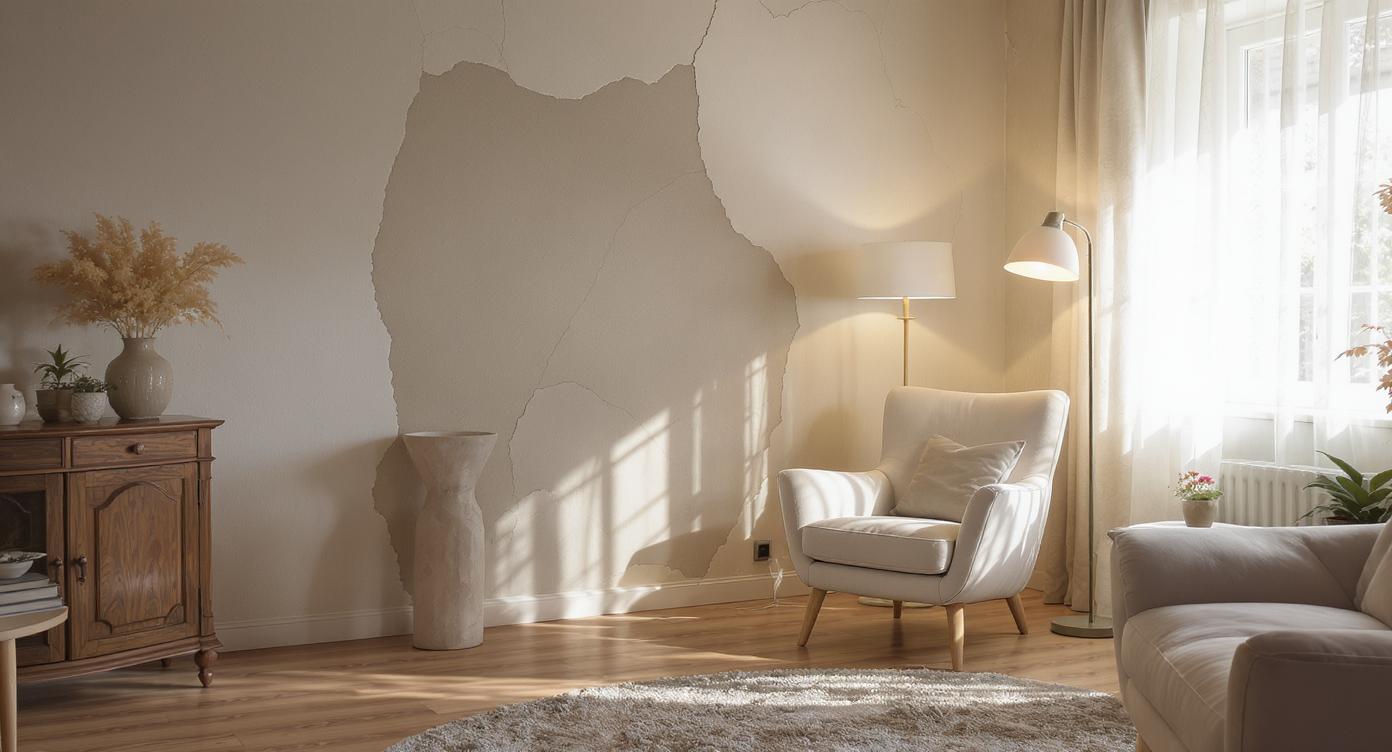
Balancing vintage character and fresh brightness in an 80s home's curved living space.
Modern yet homey, bright but not barren, original character intact. That’s the sweet spot for an 80s home with curved walls, dramatic stairs, and statement finishes. The good news: the bones you’ve got are gold. The better news: you don’t need a gut renovation to make it sing.
Here’s the thing—spaces like yours can look dark and busy because of heavy wood tones, patterned wallpaper, and older lighting temperatures. Meanwhile, the kitchen is the heartbeat for hosting, and a dismantled one is an opportunity. With a 3–4×2 m secondary kitchen behind it, you can build a dream entertaining layout that feels luxe and livable.
Below is a step-by-step plan to modernize an 80s house without losing character, plus a kitchen layout for entertaining that uses the small back room as a scullery. Short-tail keywords like modern home remodel, living room design, and kitchen layout are built in so you can find what you need fast.
Your modern‑yet‑homey game plan
Start with light: paint, glass, and bulbs. Experts recommend using high‑LRV paint to bounce light; aim for walls with LRV 70–82 and ceilings 85–90. If replacing glass, consider larger openings or floor‑to‑ceiling windows with low‑E coatings; in hot climates, look for SHGC ≤ 0.30 and add exterior shading.
- Palette: Soft whites with a hint of grey or beige (think warm gallery white), layered with mid‑tone blue‑green or charcoal accents. This cools down yellow cast without going stark.
- Lighting: 3000K LED with 90+ CRI for true color. Add dimmers and a mix of recessed, wall washers, and pendants to graze curves and highlight textures.
Unify the flooring for flow. Designers often advise one continuous surface across living, dining, and halls to visually expand space. In temperate zones, 7–8 in. wide-plank oak in a natural matte works beautifully; in hotter climates, 24×48 in. porcelain in a warm stone tone stays cool underfoot. Anchor the living area with a 9×12 rug (front legs on) to define seating without clutter.
Design a two‑kitchen entertaining layout. The show kitchen takes center stage; the 3–4×2 m back room becomes a scullery for prep and cleanup. Target 42 in. aisle clearances (48 in. if two cooks), with an island 36–42 in. deep, 72–108 in. long, and 12 in. overhang for stools spaced 24 in. apart.
- Front kitchen: Island with sink and seating; range on a feature wall; panel‑ready fridge. Add a beverage niche near the dining room.
- Scullery (back kitchen): Prep sink, dishwasher drawer, under‑counter fridge, and full‑height pantry plus open shelves; a pocket door keeps it discreet.
- Red lacquer option: If your original red cabinets are salvageable, reuse them as a statement bar or pantry wall and pair with honed black quartz. If not your style, sell or donate—someone will love them.
Honor the curves; simplify the lines. Those 80s arcs, coves, and portholes are architectural assets. Repeat the radius in softer ways: a curved island corner, a fluted console, or arched panel reveals. Replace busy striped wallpaper with smooth plaster or micro‑texture paint, keeping wall art bold but edited.
Furniture layout that hosts with ease. A floating conversation zone beats wall‑hugging every time. Place the sofa and two chairs around a 36–42 in. round or 54×54 in. square table; keep 36 in. for major walkways and 18 in. between seat and coffee table. A 90×40 in. dining table seats 8 and needs 42 in. clearance to the nearest wall.
Finish strategy: modern, not minimal. Mix matte and satin metals (polished chrome nods to the era; warm nickel softens). Choose textural fabrics—bouclé, mohair, woven linen—so the room feels cozy even with clean lines. Use 1–2 saturated accent colors in art, a rug, or that bar wall; the restraint keeps it homey, not chaotic.
Alt‑text ideas for images: “Curved staircase in bright living room with unified oak flooring,” “Two‑kitchen layout with island and hidden scullery,” “Red lacquer bar with honed black countertop in 80s modern home.”
Anecdote
A homeowner swore their living room was “small.” After unifying flooring and floating the sofa, we gained a full walkway behind the seating and added two swivel chairs. Their first dinner party ran late because no one wanted to leave the newly comfortable conversation pit.
Common mistakes to skip
Erasing the character. Stripping out the curves or coved lighting flattens the architecture. Preserve signature lines and simplify finishes around them.
Too many surfaces. Mixing dark wood, busy tile, and patterned paper chops the space visually. Unify flooring and let one feature wall or the island carry the spotlight.
Islands with tight clearances. Anything under 36 in. is frustrating; 42–48 in. works for two cooks. Plan these numbers before ordering cabinets.
Uncontrolled sunlight. Bigger windows without low‑E glass, exterior shading, or proper SHGC can overheat rooms. Specify glazing for your climate and add lined drapery.
Cold lighting temperature. 4000–5000K reads clinical at home. For living, dining, and kitchen, 2700–3000K with high CRI feels warm and still crisp.
Pro tips designers actually use
Use the scullery as your party superpower. A hidden back kitchen keeps the island clear for guests while prep and dishes disappear behind a pocket door.
- Radius details: A 2–3 in. radius on island corners echoes curved walls and increases comfort in tight pass‑bys.
- Hardware scale: On tall pantry doors, 12–18 in. pulls look intentional; on drawers, 6–8 in. centers feel balanced.
- Glass with privacy: Reeded or fluted glass for cabinet doors nods to Art Deco and hides clutter; it pairs well with curved millwork.
- Acoustic comfort: Layer a 9×12 rug, lined drapery, and an upholstered bench near the dining area to tame echo in open plans.
- Climate‑smart glazing: In hot zones, aim for U‑factor ≤ 0.30 and SHGC ≤ 0.30; in colder zones, prioritize U‑factor ≤ 0.28 and consider triple‑pane at large spans.
Reflection: I’ve seen skepticism turn to delight the first time a host realizes the scullery lets the party flow while the mess stays out of sight.
Real‑world stories from similar homes
A sofa that finally floated. One couple kept their sectional against the wall for years. We floated it, matched a 9×12 rug to the seating footprint, and the room felt twice as generous—suddenly they could host eight comfortably.
The red‑lacquer comeback. A homeowner hated their glossy red cabinets until we reframed them as a bar wall with ribbed glass uppers and a honed black top. Guests now ask who designed the “custom” feature.
Big windows, zero glare. In a hot climate, we added floor‑to‑ceiling sliders but specified low‑E glass and exterior screens. Afternoon temperatures dropped, and the living room stayed bright without the heat.
The small back kitchen that changed everything. A 3×2 m room became a scullery with a prep sink, DW drawer, and tall pantry. The main island stayed pristine during dinners for ten—cleanup happened later, with the door closed.
Visualization Scenario
Walk in at golden hour. Light skims across a curved stair, the oak floor flows unbroken to the dining room, and a round‑corner island draws you into the kitchen. Friends gather at the island while the quiet hum of the scullery stays behind a pocket door. A single vivid bar wall glows like a jewel—modern, homey, unmistakably yours.
FAQ
How do I modernize an 80s house without losing character?
Keep signature curves and coved lighting, then simplify surfaces with unified flooring and high‑LRV paint. Add 3000K lighting, one bold feature, and updated hardware to balance modern home remodel goals with original charm.
What’s the best kitchen layout for entertaining with a small back kitchen?
Use a show kitchen with a seating island and convert the 3–4×2 m back room into a scullery for prep, pantry, and cleanup. Maintain 42–48 in. aisle clearances and place a beverage station near dining for smooth traffic.
How big should my kitchen island be and how much clearance do I need?
Plan an island 36–42 in. deep and 72–108 in. long with a 12 in. overhang; allow 42–48 in. walkway clearance around it. Space stools 24 in. center‑to‑center for comfortable seating.
How can I make a dark living room feel bright without major structural changes?
Use paint with LRV 70–82, switch to 3000K 90+ CRI LEDs, and add layered lighting with wall washers and floor lamps. A larger 9×12 light rug and simplified window treatments boost reflectance and spaciousness.
Should I refinish dark floors or replace them?
Refinishing to a natural matte tone often modernizes affordably and unifies living room design across rooms. In hot climates, large‑format porcelain can replace wood to keep interiors cool while still looking seamless.
Bring it together
Lean into the architecture, lighten the shell, and let your kitchen layout do the social heavy lifting. Keep the curves, unify the flooring, and layer lighting and texture so modern doesn’t slip into minimal. When the envelope is calm, a single bold move—a red bar, a curved island, a statement pendant—reads confident and warm.
Want to test layouts, palettes, and furniture arrangements before you commit? Use an AI room visualizer like ReimagineHome to mock up the two‑kitchen plan, try floor‑to‑ceiling windows, or preview rugs and sofas in your exact space.
.svg)

.svg)

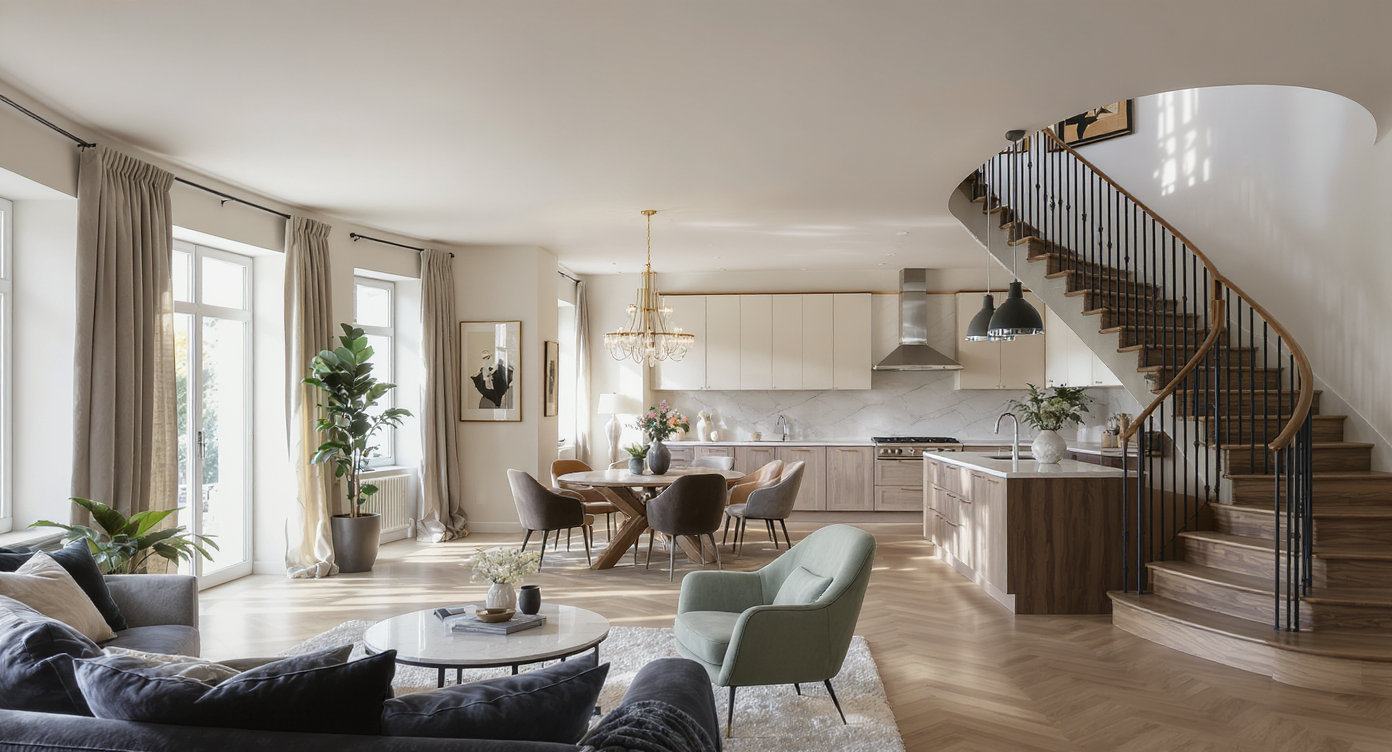
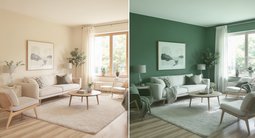
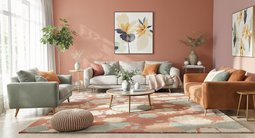
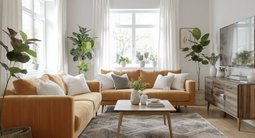


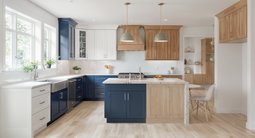

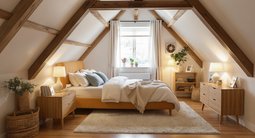
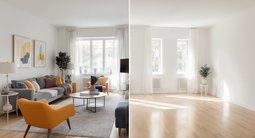


.png)